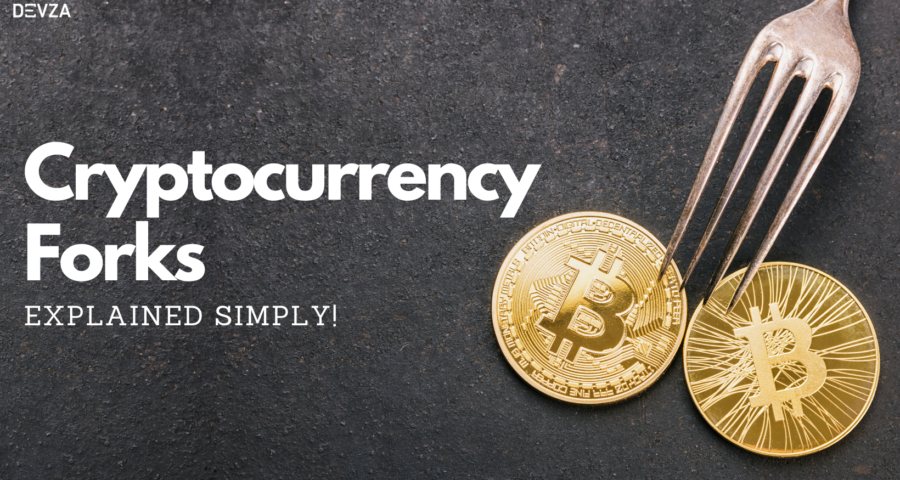What would happen if a blockchain were to split into cryptocurrency forks?
In this case, two or more blocks would have the same block height. The new chain created would share history with the original yet be headed in a different direction.
Why do cryptocurrency forks occur?
The rules used to maintain the history of a blockchain are the same for everyone. When disagreement arises, forks can form.
Forks can be accidental, or intentional.
How could a fork happen accidentally?
These forks have short lives and are made because of troubles in reaching consensus as fast as possible in a decentralized system.
Suppose more than one miner finds a block at the almost the same time. New chains would form. Then, the system would resolve this by abandoning the blocks in the chains which are shorter than the longest chain when new blocks are added.
These abandoned blocks are also called orphaned blocks.
Why would a blockchain be forked intentionally?
An intentional fork is permanent.
Permanent forks are made for a reason.
This could be to reverse the effects of hacking, such as Ethereum and Ethereum Classic; to add new features; or to avoid bugs, such as the Bitcoin fork of August 2010.
Cryptocurrencies also have independent development teams, which could initiate forks to increase security, or add functionality.
This is why cryptocurrency forks are also called a change in protocol.
Intentional forks are divided into soft and hard forks.
What is a soft fork?
Also known as a backward-compatible fork, a soft forking change is a rule change in which the old nodes still process data according to the old rules, despite new upgraded nodes existing.
This is different from a hard fork, where this old node would stop processing blocks.
Older nodes would see the new blocks mined by updated nodes as valid, while the new nodes see the blocks mined by old nodes as invalid.
These, on occasion, use miner activated updates. In this, the hash power of an update needs to equal a certain percentage before it is adopted.
They require major hash power, as otherwise they may become a hard fork.
What is a hard fork?
It is a radical software change.
In a hard fork, the old network nodes following the old software would see the blocks formed using the new rules as invalid. This means, the nodes must upgrade their software.
If a transaction is included in both forks, this means it follows the rule of both forks.
Hard forks offer better security and are thus favoured. They can build stability for the blockchain, and lead to more decentralization.
For a clean fork, enough nodes need to adopt the new protocol software.
If one faction of nodes keeps following the old rules while the rest have upgraded their software, a hard fork would occur.
If a large enough faction decides that they would rather use the old rules, a chain split would occur, due to which two new currencies would exist side by side.
This is why hard forks require a consensus from coin holders with a connection to the coin network.
Hard forks are not backwards compatible.
Have any major hard forks happened recently?
Yes.
In the case of Ethereum and Ethereum Classic, in 2016, Ethereum was hard forked to mitigate the effects of a hacking of The DAO. This was done to “make whole” the investors of The DAO.
In 2017, Bitcoin was forked to create Bitcoin and Bitcoin Cash. This was due to a fundamental disagreement in the Bitcoin community about how TPS could be heightened to meet demand.
One branch inherited Bitcoin core software while the other inherited Bitcoin Cash software. Bitcoin Cash did not inherit the SegWit (Segregated Witness) protocol.
How does a fork impact the cryptocurrency?
Forks can be quite controversial, and often cause large price fluctuations in the cryptocurrency.
There can be two results of a fork.
The first is that one blockchain becomes dominant, while the other has low community adoption, and thus, less value.
This is a conclusion seen with the fork of Ethereum. Ethereum is far more dominant when compared to Ethereum classic.
The second, is that both exist together and operate independently, with roughly equal adoption.
Bitcoin and Bitcoin Cash had this outcome. Bitcoin Cash is currently ranked 14th on the list of largest cryptocurrencies. It is the most successful hard fork of Bitcoin.
For the community, forks can be unsettling.
For instance, in the case of Bitcoin and Bitcoin Cash, a faction believes that only Bitcoin Cash truly follows the vision of Satoshi Nakamoto (the creator of Bitcoin). There is still a great deal of disruption between the communities.
Also, those owning coins in the parent cryptocurrency could, in some cases, such as that of Bitcoin and Bitcoin Cash, end up with an equal number of coins of the fork, which leads to fascinating economic consequences.
When forks only copy the underlying code, this does not happen, such as with Ethereum and Ethereum Classic. In this case, traders can abandon the old cryptocurrency almost entirely.
In conclusion, if you own a cryptocurrency, you must stay updated with news of it, and this includes the possibility of forks. As the crypto community is flourishing, it is a must to participate in online forums and social media, as when new forks occur, that is where the most information will be found.


Leave a Reply